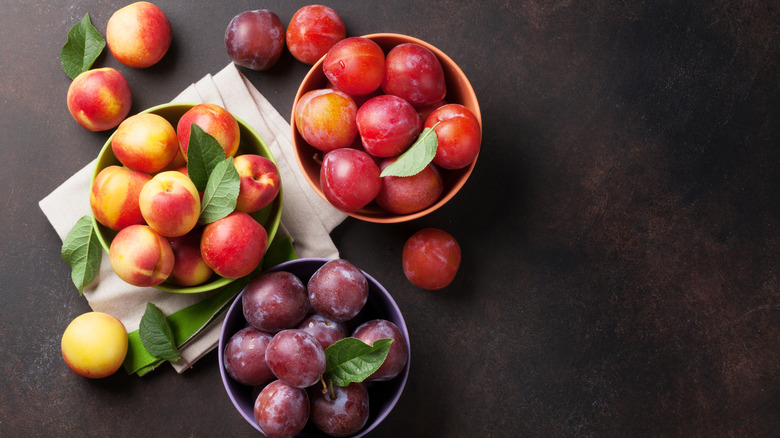You Need To Stop Storing Your Stone Fruit In The Fridge
When the welcoming warm days of summer roll around, all you crave is a relaxing day in the sun, taking bites of juicy stone fruit like peaches to cool you down in the hot sun. But as delicious stone fruit abounds, you'll need a way to store them so you can still enjoy them days later. And even though your instinct may be to toss them in the crisper drawer of the refrigerator, you may be ruining your stone fruit instead of preserving it.
When fresh stone fruit is stored in the fridge, the ripening process is effectively slowed down. While this can help ripe stone fruit last longer, it'll muzzle their bright, sweet flavors and begin turning their skin and flesh mealy. The consequence of missing out on that perfectly smooth, juicy bite of a peach or nectarine doesn't make storing stone fruit in the fridge really worth it. If you're waiting for the fruit to ripen, keep them out on the countertop at room temperature instead. You can feel the stone fruit is ripe if it gives a little bit to the touch. Then make sure to enjoy it within a day or two.
How to properly store your stone fruits
You'll want to avoid a few mistakes when storing your fruit, even after you've started storing them on the countertop instead of the fridge. Though it might be tempting to wash all your produce after a haul at the grocery store or farmer's market, don't wash your stone fruit. Instead, wash the fruit only just before eating. If you wash the fruit ahead of time, that extra moisture will seep into the fruit and deteriorate the skin, giving it that unwanted mushy texture.
The one exception to this no-refrigerator rule is cherries. Cherries are best stored in a bag and in the refrigerator. Avoid typical plastic baggies, as they can suffocate the fruits by trapping the ethylene gas that ripens the fruit faster. Instead, try to find a breathable produce bag. Produce bags are usually made of a mesh material, allowing the ethylene gas to circulate out, in turn keeping your cherries fresher for longer.
When you leave your stone fruit out on the counter, keep in mind that there are some kinds of fruit you should never store near potatoes, such as peaches. That ethylene gas from the peaches could encourage sprouting in your potatoes, turning them bad quickly.
Enjoying delicious stone fruit once ripe
Now that you've properly stored your stone fruit, it's time to figure out how best to enjoy them. While you can simply chomp away on plums and peaches as is, you may want to slice them up for serving or eating with a fork instead. The best way to easily pit your stone fruit is to treat it like an avocado, slicing the outside of the fruit in a circular motion and twisting it to separate it in half. Then, just use a paring knife to carefully remove the pit.
If you need to peel the skins of a peach or nectarine, such as when incorporating the fruit into a baking recipe, you may struggle a bit with peeling the skins. To help, try dropping the fruits briefly into a pot of boiling water and immediately plunging them into an ice bath afterward. They only need about 30 seconds to a minute to gently soften in the boiling water. Once they've cooled down, the skins should easily fall away from the fruit. Whether you're baking, slicing, or simply biting into juicy stone fruit, you'll be glad you stored them outside of the refrigerator to enjoy them at their smoothest and sweetest.


